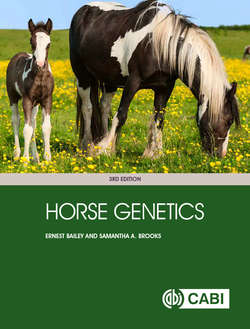Читать книгу Horse Genetics - Ernest Bailey - Страница 61
На сайте Литреса книга снята с продажи.
Mitosis
ОглавлениеWhen body cells divide, the chromosomes first replicate, then condense by tight coiling (as already described) to become the discrete chromosome elements shown in a karyotype. At cell partition, the duplicated strands separate so that each daughter cell has an exact replica of the genetic material of the original cell. This process assures that all cells of the body are genetically identical and have the normal chromosome number (the diploid number). For domestic horses, this diploid chromosome number is 64, a collection of 32 pairs of chromosomes. One chromosome of each pair has a maternal origin, the other a paternal origin.
Meiosis
Meiosis generates gametes (sperm in males and ova in females) with only 32 chromosomes (the haploid number)—only one copy from each of the chromosome pairs found in normal diploid cells. When a sperm and an ovum combine during fertilization to form a zygote, the chromosome number in the resulting cell is 64, reconstituting the diploid chromosome number and gene composition appropriate for the animal we know as the horse.
Integral to meiosis are two aspects directly responsible for the characteristics of gene inheritance.
• Reduction division, which results in the gamete receiving only one chromosome of each pair. Thus, chromosomes derived from each parent are randomly distributed through the children and on to the grandchildren. This process reassorts chromosome pairs in each generation and generates characteristic trait ratios and segregation of alleles. Mendel did not know about chromosomes, but he hypothesized this kind of process to explain inheritance.
• Recombination, which allows homologous maternal- and paternal-derived chromosomes to exchange sections. This crossing-over process was not part of the genetic theory hypothesized by Mendel but is the basis for the important concept of linkage genetics.
An animal has only two copies of each gene despite the genetic input from many pedigree elements. For example, all four grandparents will provide material to the overall genetic makeup of a grandchild, although for each specific gene only two grandparents, one from the paternal side and one from the maternal side, will be represented. Certain groups of genes are likely to be co-contributed because genes are closely strung together on linear chromosomes. Meiosis ensures that genes on different chromosomes, or far apart on one chromosome, are unlikely to stay together beyond a few generations.
This summary of the cell division processes is by necessity brief. Consult a basic text on genetics for a more detailed review. For this topic, it would make very little difference for understanding the fundamental process whether a mouse, a fly, or a horse was the example. From the description of the various cell and chromosome division processes, and basic to all that follows, the key point to understand is that individual genes—the units of heredity—are passed on unaltered from parent to offspring, but the gene combinations are changed in every generation.
